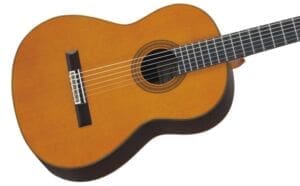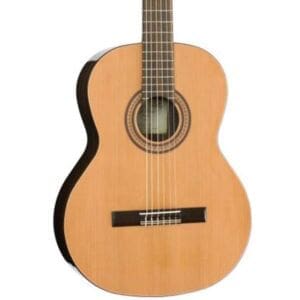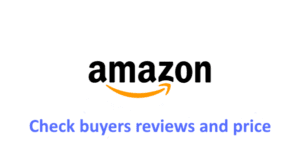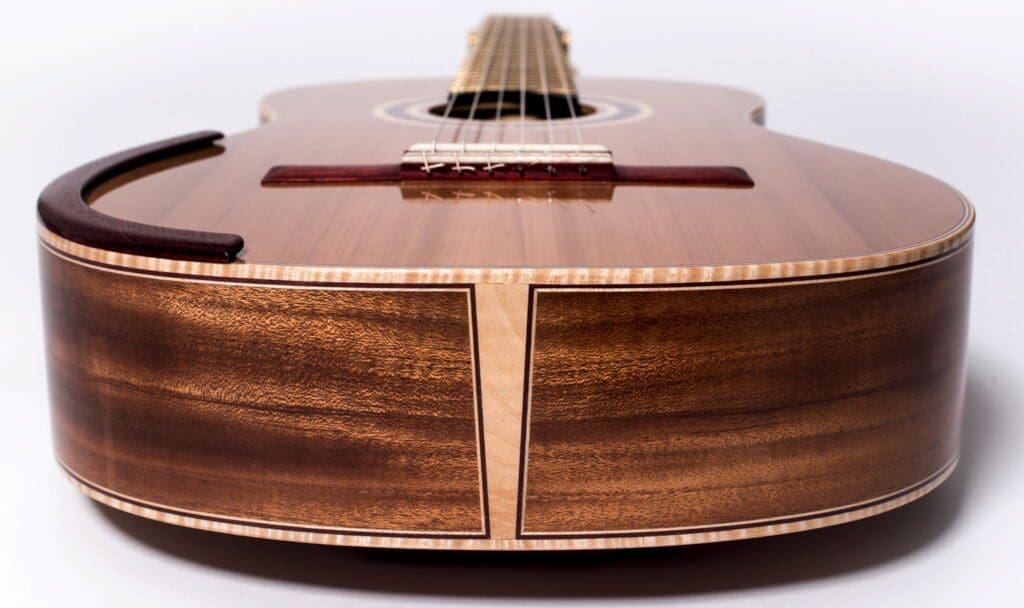Last update 15/1/2024
If you have a passion for classical music’s rich and enchanting tones, we will offer our opinions on the best classical guitar for the money. In 2024, the market is brimming with exceptional classical guitars, each offering its unique characteristics and nuances to elevate your musical journey.
In this friendly and informative classical guitar buying guide, We’ve carefully categorized 12 of the best classical guitars to suit various preferences and playing styles.
Best Basic Guitars
Table of contents
- Best Basic Guitars
- Our Suggestions for the Best Classical Guitar for the Money
- The Distinctive Features of Classical Guitars
- Our Guide to Picking the Best Classical Guitar
- Understanding the Differences between a Classical Guitar and a Steel String Acoustic
- Finding the Right Size and Shape for Your Playing Comfort
- Best Classical Guitar for the Money – Top Brands and Their Features
- Understanding Different Playing Styles in Classical Music
- Essential Accessories for Classical Guitar Players
- The Nylon String Difference: Warmth and Versatility
- Headstock Design: The Classic Slotted Head vs. Solid Headstock
- Sound Projection: The Influence of Body Shape and Size
- Fretboard Width and Scale Length: Comfort vs. Playability
- Budget Considerations: Balancing Quality and Price
- Caring for Your Classical Guitar
- Conclusion
Our Suggestions for the Best Classical Guitar for the Money
Whether you’re a seasoned classical player or a beginner exploring this beautiful genre, let’s dive into our selection and discover the perfect classical guitar that resonates with your heart and soul!
1. Cordoba C10
The Cordoba C10 is a flagship classical guitar with exceptional craftsmanship and tonal quality. The guitar’s solid Canadian cedar top produces warm, rich tones with excellent projection. The Indian rosewood back and sides enhance this instrument’s overall resonance and sustain.
The C10’s playability is top-notch, with a comfortable neck and smooth ebony fingerboard. It’s a versatile instrument suitable for classical, flamenco, or various other styles of music. The attention to detail in its construction is very evident, with beautiful inlays and a hand-inlaid wooden rosette.
The Cordoba C10 is a premium classical guitar that justifies its price tag. It’s an excellent choice for intermediate to advanced players looking for a guitar that delivers exceptional sound and aesthetics.
Specifications:
Top: Solid Canadian Cedar
Back & Sides: Solid Indian Rosewood
Neck: Mahogany
Scale Length: 25.6″
Fingerboard: Ebony
Nut Width: 2.04″
Finish: Polyurethane Gloss
2. Yamaha GC32C
The Yamaha GC32C is a high-quality classical guitar that blends traditional craftsmanship with modern design. It features a solid European spruce top with clear and articulate tones, making it a great choice for classical guitar music.
The guitar’s Indian rosewood back and sides contribute to its warm and well-balanced sound. Yamaha’s meticulous construction ensures consistent quality; this is a top-notch guitar for advanced players and serious students.
The GC32C offers comfortable playability with a slim neck and an ebony fingerboard. It’s a reliable instrument known for its durability and stability.
While it may not have the same level of aesthetic detailing as some other high-end models, the Yamaha GC32C shines in terms of sound quality and affordability.


Specifications:
Top: Solid American Cedar
Back & Sides: Solid Mahogany
Neck: African Mahogany
Scale Length: 25.59″
Fingerboard: Ebony
Nut Width: 2.05″
Finish: Gloss
Category 3: Best Budget Classical Guitars
3. Kremona Fiesta FC
The Kremona Fiesta FC is a mid-range classical guitar known for its affordability and decent performance. It features a solid European spruce top and Indian rosewood back and sides, which combine to produce a balanced and warm tone.
While the Fiesta FC may not have the same level of craftsmanship and attention to detail as some higher-end models, it offers a good value for its price point. The guitar’s playability is comfortable for beginners and intermediate players.
It’s an excellent choice for those just starting their classical guitar journey and wanting a reliable instrument without breaking the bank. However, serious players may eventually outgrow its limitations.


Specifications:
Top: Solid Red Cedar
Back & Sides: Sapele
Neck: Honduras Cedar
Scale Length: 25.6″
Fingerboard: Indian Rosewood
Nut Width: 2.04″
Finish: High Gloss
4. Yamaha C40
The Yamaha C40 is an entry-level classical guitar designed for beginners. It’s an affordable option that provides a solid foundation for those new to classical guitar playing.
The C40 features a spruce top and meranti back and sides. While it may not offer the same level of tonal complexity as higher-end models, it produces a clear and bright sound suitable for practice and learning purposes.
Its playability is comfortable, and the guitar is lightweight and easy to handle. The Yamaha C40 is an excellent choice for beginners on a budget or anyone looking for a low-risk introduction to classical guitar.
Specifications:
Top: Spruce
Back & Sides: Meranti
Neck: Nato
Scale Length: 25.6″
Fingerboard: Rosewood
Nut Width: 2.0625″
Finish: Gloss
Category 4: Best Student Classical Guitars
5. Cordoba C3M
The Cordoba C3M is another entry-level classical guitar that offers a blend of affordability and quality. It features a solid cedar top and mahogany back and sides, resulting in a warm and mellow tone.
The C3M is known for its comfortable neck and ease of playability, making it an ideal choice for beginners. It’s a durable instrument that can withstand the rigors of practice.
While it may not have the same level of refinement as Cordoba’s higher-end models, the C3M provides excellent value for beginners and casual players seeking a dependable and budget-friendly classical guitar.


Specifications:
Top: Solid Cedar
Back & Sides: Mahogany
Neck: Mahogany
Scale Length: 25.6″
Fingerboard: Rosewood
Nut Width: 2.04″
Finish: Satin
6. La Patrie Etude
The La Patrie Etude is a well-crafted student classical guitar focusing on playability and affordability. With its solid cedar top and wild cherry back and sides, this guitar delivers a warm, balanced tone that’s ideal for those starting their musical journey.


Specifications:
Top: Solid Cedar
Back & Sides: Wild Cherry
Neck: Mahogany
Scale Length: 25.66″
Fingerboard: Rosewood
Nut Width: 2.05″
Finish: Satin
Category 5: Best Travel Classical Guitars
7. Cordoba Mini II FMH
The Cordoba Mini II FMH is a compact and versatile travel classical guitar perfect for musicians on the go. With its solid spruce top and flamed mahogany back and sides, this guitar offers a surprisingly full sound, making it an ideal companion for travel and practice.
Specifications:
- Top: Solid Spruce
- Back & Sides: Flamed Mahogany
- Neck: Mahogany
- Scale Length: 22.875″
- Fingerboard: Pau Ferro
- Nut Width: 1.96″
- Finish: Satin
The Distinctive Features of Classical Guitars
Our Guide to Picking the Best Classical Guitar
In this guide, we’ll explore the differences between classical and steel-string acoustic guitars, distinctive features of classical guitars, finding the right size and shape for your comfort, top classical guitar brands, various playing styles in classical music, essential accessories, the warm tones of nylon strings, headstock design, sound projection, fretboard width, budget considerations, and caring for your classical guitar. So, let’s dive in and set you on the path to finding your perfect match!
Understanding the Differences between a Classical Guitar and a Steel String Acoustic
Before we delve into the specific aspects of classical guitars, we must grasp the fundamental differences between classical guitars and steel-string acoustics. Classical guitars feature nylon strings, while steel-string acoustics, as the name suggests, have steel strings. Nylon strings impart a warm and mellow tone to classical guitars, ideal for classical, fingerstyle, and flamenco music. On the other hand, steel-string acoustics produce a brighter and more robust sound suitable for folk, country, and contemporary styles.
Classical guitars possess several unique features that contribute to their distinct identity. These features include a wider neck, flatter fretboard, and softer strings. The wider neck allows for more precise finger placement, making complex chord shapes and intricate fingerpicking patterns easier. The flatter fretboard facilitates comfortable string bending and sliding.
Additionally, classical guitars generally have a smaller body size than steel-string acoustics, enhancing their playability while keeping their rich tonal quality. Combining these features creates a well-balanced and versatile instrument suited for various musical genres.
Finding the Right Size and Shape for Your Playing Comfort
Choosing the right size and shape of a classical guitar is crucial for your playing comfort and overall enjoyment. As mentioned earlier, classical guitars come in various sizes, ranging from full-size (4/4) to smaller sizes like 3/4, 1/2, and 1/4. For adult players, a full-size guitar is the standard choice. However, if you’re purchasing a guitar for a child or have smaller hands, opting for a smaller size ensures a more comfortable playing experience and improved technique.
Body shape is another consideration to keep in mind. Classical guitars are available in various designs, such as standard, grand concert, and grand auditorium. Each shape offers a unique tonal profile and playing experience. Take your time to try out different sizes and body shapes to find the one that fits your playing style and physical comfort.
Best Classical Guitar for the Money – Top Brands and Their Features
Choosing a reputable brand ensures quality craftsmanship and a reliable instrument. Some of the top classical guitar brands include Cordoba, Yamaha, Alhambra, and Ramirez. Each brand offers a wide range of models, catering to different skill levels and musical preferences. While Yamaha provides affordable options for beginners, Cordoba and Alhambra are known for producing high-quality instruments suitable for intermediate and advanced players. Ramirez, a legendary brand, crafts top-tier classical guitars favored by professional musicians.
Understanding Different Playing Styles in Classical Music
Classical music encompasses diverse styles, each needing specific techniques and tones. Understanding the various playing styles will help you choose a classical guitar that best suits your musical aspirations. For example, a guitar with a spruce top and a brighter tone may be preferable if you’re interested in traditional classical music. Conversely, if you’re drawn to flamenco, a guitar with a cedar top and a more expressive sound will complement this style.
Explore different genres within classical music and identify the styles that resonate with you. This will help you find a classical guitar that caters to your musical preferences.
Essential Accessories for Classical Guitar Players
Investing in essential accessories enhances your playing experience and protects your instrument. A sturdy guitar case will safeguard your classical guitar during transport and storage. A high-quality guitar strap will provide comfort during long playing sessions.
Additionally, consider buying a footstool or guitar support to maintain proper playing posture. A metronome and tuner are indispensable tools for developing a steady sense of rhythm and keeping your guitar in tune.
The Nylon String Difference: Warmth and Versatility
Using nylon strings in classical guitars is a defining feature that contributes to their warm and expressive tone. The softer nylon strings produce less tension on the guitar’s neck, making it more comfortable to play for extended periods. This aspect is especially beneficial for beginners and players with hand fatigue.
Moreover, the nylon strings offer versatility in terms of tone and technique. Classical guitarists can achieve delicate fingerpicking patterns, intricate arpeggios, and expressive legato passages due to the nylon strings’ pliable nature.
Headstock Design: The Classic Slotted Head vs. Solid Headstock
The headstock design of a classical guitar can significantly impact its tuning stability and overall looks. The traditional slotted headstock features open slots where the strings are tied, allowing for easier string changes. This design is often associated with a more vintage and elegant appearance.
On the other hand, some modern classical guitars feature a solid headstock with mechanical tuners similar to those found in steel-string acoustics. This design offers quicker and more precise tuning adjustments, appealing to players who prefer a contemporary look and convenience.
Sound Projection: The Influence of Body Shape and Size
The size and shape of a classical guitar’s body influence its sound projection and tonal balance. Smaller-bodied guitars are known for their focused and articulate sound, making them suitable for solo performances and intimate settings. Larger-bodied guitars offer a more robust and resonant sound, ideal for ensemble playing and projecting sound in larger venues.
Consider the intended use of your classical guitar when picking its body size. A medium-sized guitar may strike the perfect balance between projection and comfort if you plan to perform in various settings.
Fretboard Width and Scale Length: Comfort vs. Playability
A classical guitar’s fretboard width and scale length play a vital role in its playability. A wider fretboard provides more space between strings, allowing for precise finger placement and reducing the chance of accidental muting. However, players with smaller hands may find a narrower fretboard more comfortable and conducive to faster playing.
Scale length refers to the distance between the nut and the guitar saddle. A longer scale length generally results in higher string tension, which can affect the overall feel and sound of the guitar. Players seeking a more powerful and projecting sound may prefer longer scale lengths, while shorter scale lengths may appeal to those seeking greater playability and ease of fretting.
Budget Considerations: Balancing Quality and Price
Your budget plays a significant role in determining the range of classical guitars available to you. As a beginner, it’s reasonable to start with a moderately priced instrument that offers good playability and sound quality. Higher-priced models often boast premium materials, superior craftsmanship, and enhanced tonal characteristics, making them suitable for advancing players or professionals.
Remember that a more expensive guitar does not necessarily equate to a better fit for your needs. It’s essential to balance quality with your budget and prioritize a comfortable guitar that sounds pleasing to your ears.
Caring for Your Classical Guitar
Proper maintenance and care are key to keeping your classical guitar in optimal playing condition and extending its lifespan. Here are some tips to ensure your guitar remains in top shape:
Keep your guitar in a stable environment, avoiding extreme temperatures and humidity fluctuations.
Clean the guitar regularly with a soft, dry cloth to remove dust and fingerprints.
Change your strings regularly to maintain a fresh and vibrant tone.
Protect the guitar from potential damage by using a sturdy case or gig bag during transport.
Schedule regular check-ups with a professional luthier to address any potential issues and maintain the guitar’s playability.
Conclusion
Hopefully, you are now armed with a deeper understanding of the differences between classical and steel-string acoustic guitars, the distinctive features of classical guitars, and essential considerations such as size, tonewood, and budget; you’re now equipped to make an informed decision.
Finding the right classical guitar is a personal and rewarding process. Take your time, try out various guitars if you can, and trust your instincts. Whether you’re a beginner or an experienced player, the perfect classical guitar will become your musical companion, inspiring you to explore the captivating world of classical music. Happy playing!
Transparency disclosure: Some of the links in this post are affiliate links, meaning that I may earn a commission if you click on a link and make a purchase. This commission comes at no extra cost to you. We only recommend products and services that I believe are helpful and valuable, and we never let the potential for a commission influence our recommendations.





